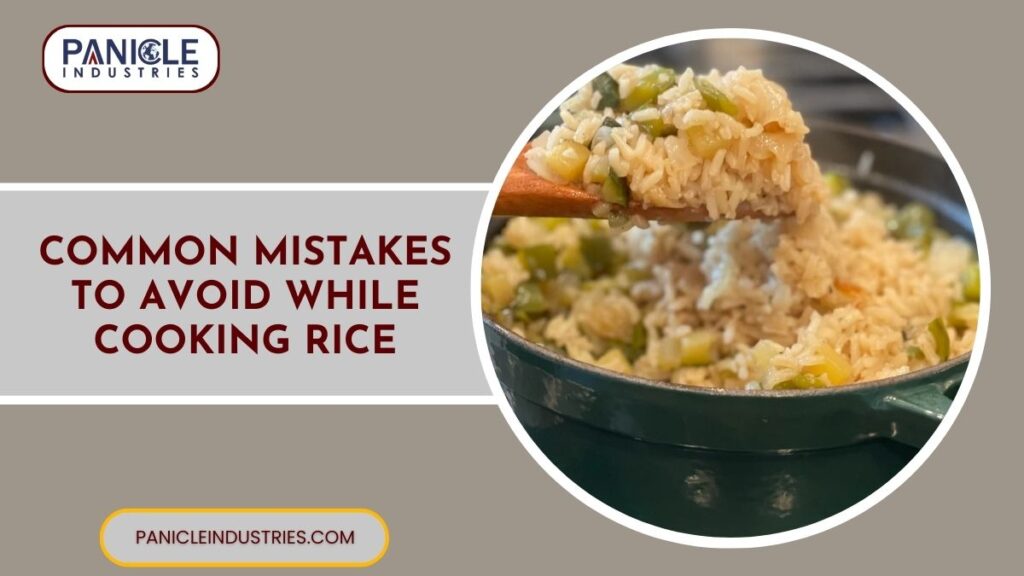Cooking rice seems simple, yet many people find it challenging to get it right every time. Whether it turns out too sticky, too dry, or unevenly cooked, rice can be tricky if not handled properly. Understanding the common mistakes to avoid while cooking rice can save you from kitchen disappointments and help you serve soft, fluffy grains that complement any meal. Since rice is a staple in many cuisines, it is important to master its preparation.
From washing the rice to controlling the water ratio and cooking time, every step plays an important role. By avoiding these mistakes, you can make perfectly cooked rice that is light, flavorful, and enjoyable with any dish.
Common Mistakes To Avoid While Cooking Rice
1. Not Washing Rice Before Cooking
One of the most frequent mistakes people make is skipping the washing step. Raw rice often has excess starch on the surface. If you do not rinse it, the grains can become sticky and clump together. Washing rice two to three times in fresh water helps remove this starch and any impurities. Clear water is a good sign that the rice is properly rinsed. For varieties like basmati or jasmine, this step is especially important to achieve fluffy, separate grains. Skipping this simple process often results in mushy rice, which may not look or taste pleasant.
2. Using the Wrong Water-to-Rice Ratio
Water measurement plays the biggest role in how rice turns out. Too much water can make the rice soggy and overcooked, while too little water can leave it hard and undercooked. The correct ratio usually depends on the type of rice you are cooking. For example, long-grain basmati rice often needs about 1 cup of rice to 1.5–2 cups of water, while brown rice requires more. Always check the package instructions and measure carefully. Guessing the ratio is a mistake many people make, and it directly affects the final texture of the rice.
Also read: Why Does My Rice Cooker Take So Long to Cook Rice?
3. Cooking Rice on High Heat All the Time
Another common mistake is cooking rice entirely on high heat. High heat may bring the water to a boil quickly, but it can also cause the water to evaporate before the rice is cooked properly. This results in uneven cooking, with some grains undercooked and others mushy. The correct way is to first boil the water, then add the rice and reduce the heat to low. Allow the rice to simmer gently with the lid on. This slow cooking method ensures that the rice absorbs water evenly and turns out soft and fluffy.
4. Lifting the Lid Too Often
Many people cannot resist the urge to check on rice while it is cooking. However, opening the lid too often lets out the steam that is necessary for proper cooking. Steam helps the rice absorb water evenly. Every time you lift the lid, you disturb this process and may end up with unevenly cooked rice. It is best to keep the lid closed and trust the cooking time. Only open the pot when you are sure the rice is done. A little patience can make a big difference in achieving perfect results.
5. Stirring Rice While It Cooks
Unlike pasta, rice does not need stirring while it cooks. Stirring breaks the grains and releases more starch, which makes the rice sticky and clumpy. Some people stir because they worry the rice will stick to the bottom, but using the correct amount of water and a heavy-bottomed pot prevents this. It is better to leave the rice undisturbed while it simmers. Once it has absorbed the water, you can fluff it gently with a fork instead of stirring. This helps the grains remain separate and light.
6. Not Letting Rice Rest After Cooking
Resting rice after cooking is an often-overlooked step. Many people serve rice immediately, but allowing it to sit for about 10 minutes with the lid on can improve the texture. During this resting period, the steam redistributes evenly, and the rice firms up slightly. This prevents it from being too wet or sticky when served. Skipping this step can lead to clumps or uneven textures. By resting the rice, you give it time to settle, making it easier to fluff and serve beautifully on the plate.
7. Ignoring the Type of Rice
Not all rice varieties cook the same way. A mistake many beginners make is treating all rice the same. For instance, basmati rice needs less water and has a shorter cooking time compared to brown rice, which requires more water and longer cooking. Jasmine rice has its own unique cooking method as well. Using one method for all types of rice usually results in disappointment. Always check the instructions on the package or research the right method for the rice you are cooking. Respecting the type of rice ensures the best results.
8. Adding Too Much or Too Little Salt
Rice may look plain, but a small amount of salt enhances its flavor. Many people either forget to add salt or add too much, which affects the taste. Adding salt to the cooking water allows the grains to absorb the seasoning evenly. If you skip this step, your rice may taste bland, even when served with flavorful dishes. On the other hand, too much salt makes it unpleasant and hard to balance with other foods. The key is moderation—just a pinch or two depending on the quantity of rice.
9. Using the Wrong Pot or Pan
The type of cookware you use matters more than most people realize. A thin-bottomed pot may cause the rice to burn at the bottom before it finishes cooking. Similarly, using a pot that is too small can cause water to overflow and create a mess. The best choice is a heavy-bottomed pot with a tight-fitting lid. This ensures even heat distribution and proper steam circulation. By choosing the right pot, you avoid half-cooked or burnt rice and enjoy a better cooking experience overall.
10. Not Practicing Enough
Lastly, one of the biggest mistakes is expecting perfect rice without practice. Cooking rice is a skill, and like any skill, it improves with time. Many people give up after one or two failed attempts, but consistency is important. Every type of rice may need small adjustments based on your stove, pot, or preference. Practicing helps you find the right balance for your kitchen. Over time, you will naturally understand how much water to use, how long to cook, and when the rice is ready without even checking.
Conclusion
Perfectly cooked rice can transform a meal, while poorly cooked rice can spoil even the best dishes. By knowing the common mistakes to avoid while cooking rice, you can improve your cooking skills and serve fluffy, delicious grains every time. Simple steps like washing the rice, measuring the water properly, controlling the heat, and letting it rest after cooking make a big difference. Paying attention to the rice variety and using the right pot also ensures better results. With practice and patience, anyone can master the art of cooking rice. Avoid these mistakes, and you will never struggle with rice again.


